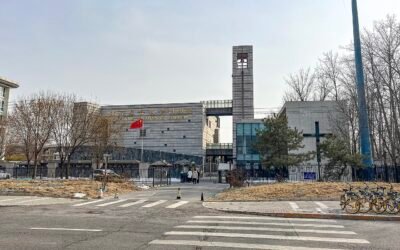The CCP continues to close down and demolish Buddhist places of worship across China. Even the ones approved by the government are not spared.
by Yang Xiangwen
Qingliang Temple in Huailai county, administered by Zhangjiakou city in the northern province of Hebei, was built during the reign of Wanli Emperor (1563-1620), the 14th emperor of the Ming Dynasty, and was home to a seven-story pagoda, which was very popular with the local people.

The pagoda in the Qingliang Temple before it was demolished.
In October last year, the local government blew up the pagoda on the grounds that “it was built without approval.” With a loud noise, the building was turned into ruins amidst thick smoke. The same day, the Qingliang Temple was also demolished.
Video: The seven-story Buddhist pagoda in Qingliang Temple was blown up in October
According to an eyewitness, armed police officers cordoned off the intersection leading to the pagoda to prevent villagers from protesting against the demolition. The local government demanded to block the mobile service throughout the entire area to avoid information leaks. A Buddhist who has lived in the temple tried to get inside to take her personal belongings, but the police stopped her, warning to arrest anyone who tries to enter.A local Buddhist told Bitter Winter that the original Qingliang Temple was destroyed in earlier years and was rebuilt with donations from local people in 2014. The reconstruction was approved by the local China Buddhist Association as well as the county, town, and village governments. The pagoda was built three years later.
In mid-August, local officials ordered the temple director to demolish the temple, or the government would do it for him. “The temple and pagoda are the village’s property, but the government destroyed it, without considering the resident’s feelings,” villagers were angry.
A pagoda in a Buddhist temple in the eastern province of Shandong was also repeatedly suppressed. According to a local Buddhist, the 13-story pagoda, built in 2018, had 75 statues in total. When it was finished, local officials came for an inspection and concluded that because no approval had been issued, the pagoda was an illegal construction, as per the central government’s policy. They threatened to fine the temple’s director and demolish the pagoda if he did not remove the statues. The Buddhist refused.
The pressure against the temple didn’t subside, and in May 2019, the director had to remove all the statues. In late June, dozens of government and public security personnel joined forces to demolish the pagoda, but they didn’t manage to do that. Local Buddhists worry that the pagoda will be destroyed eventually.

All the statues have been removed from the pagoda and piled together.
In May, the local Religious Affairs Bureau of Taian city in Shandong closed down Zengfu Temple, driving away all the monks who lived on the premises, because it did not have the religious activity venue registration certificate. In the following two months, officials returned to the temple twice for inspection. They stopped harassing the temple only when they saw its courtyard overgrown with weeds and all Buddhist statues gone.
A local government insider told Bitter Winter that the state is afraid that members of religious groups it doesn’t control may have contacts with foreign countries, in particular the United State. “The government wanted to prevent upheavals as the 70th anniversary of the founding of the People’s Republic of China was marked in 2019,” the insider commented.

Uses a pseudonym for security reasons.



